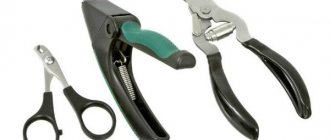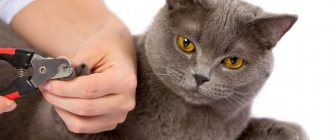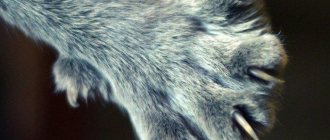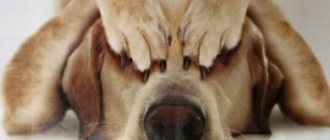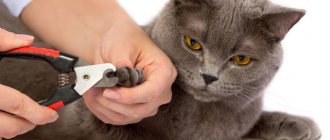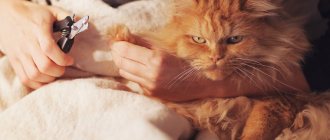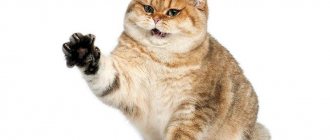Every pet owner will sooner or later face the problem of tattered furniture and wallpaper. The question will arise: can a cat’s claws be trimmed, and is such an ambiguous procedure dangerous for the pet? In the wild, animals wear down their claws naturally, climbing trees and running on hard surfaces. Pets often do not have such opportunities. So they have to sharpen their scratches on what they see in the apartment. And there is no escape from this; instinct is inherent in the animal by nature itself. It is possible to cope with such a problem, you just need to be well prepared.
Why do you need to trim your nails?
First of all, this is the cat's main weapon for protection and a hunting tool.
On the streets of the city, the animal has many enemies, from whom only teeth and sharp claws can help. Also, the cat’s natural arsenal allows him to win the lady of his heart or climb a tall tree in case of danger. Rodents are destined to become a hearty meal for lucky hunters with sharpened nails. However, pet owners ask the question: why trim a cat’s claws if it doesn’t go outside? And how to cut it correctly so as not to harm the animal? This treatment is needed, first of all, to prevent diseases and prevent abnormal growth of claws. Sharp, long claws can cause damage if they fall from a height. Another reason is to preserve the interior decor of the room (furniture, walls, interior items) and clothing. The process of scratching household utensils leads to scandals that negatively affect the mental state of both the cat and the residents of the apartment.
Leave a request for a cat hotel
There are good reasons when to apply a haircut:
- Keeping a cat at home. The animal is kept indoors only and does not go outside on its own. Because it is impossible to sharpen its claws in nature, it is forced to scratch furniture and walls, ignoring the scratching post.
- Having small children in the apartment. Sharp claws pose a danger to infants and preschoolers. In the game, an animal can injure a child and cause an infection.
- In case of illness or low mobility. An unhealthy cat cannot carry out hygiene activities on its own. Also, when a pet has an infantile temperament, is old or is overweight, then human help is needed.
- For preventive purposes, for aesthetics. Removing the upper part of the claws is important to prevent the occurrence of purulent foci of inflammation. The procedure is mandatory when the cat participates in exhibitions, for safe bathing.
It should be remembered that trimming nails causes deep stress in the animal. Therefore, the owner must analyze all the pros and cons. The need for the procedure must outweigh the risk of problems.
Is there an alternative: “soft paws” and “anti-scratch pads”
In fact, there is only one alternative and how humane it is is the question. We are talking about an operation to remove claws - onychectomy. The need for it may arise in case of severe claw disease, traumatic damage to the fingers, or excessive aggressiveness of the animal. But in recent years, some animal owners are doing this without medical indications, but only to prevent their animals from damaging their furniture.
The glamorous name “soft paws” actually hides the amputation of the last claw phalanx on the animal’s toes. The operation is performed under general anesthesia, which in itself is a serious test for the animal’s body. Removal of claws can lead to a number of diseases and affect the psyche and behavior of an animal deprived of an innate tool, but not the need to use it.
A more humane method to prevent damage to hands and furniture is silicone claws or “anti-scratches.” These are silicone caps that are glued to the claw with special glue. They produce several sizes for cats of different ages and breeds, and all kinds of colors. Multi-colored caps not only allow you to be creative in choosing a manicure, but also make it easier to find and clean up fallen nails. The latter is especially true for families with small children and other animals who may pick up and eat something from the floor.
The gluing procedure is in many ways similar to trimming nails and is no less stressful for the animal. It should be taken into account that silicone pads change the animal’s tactile sensations when walking, playing, and affect jumping and the ability to climb objects.
Experts have differing opinions regarding silicone claws. On the one hand, there is no particular harm from them, and in comparison with “soft paws” they are completely harmless. But, on the other hand, for the animal it is stress and suppression of instincts.
Perhaps reviews from more experienced cat owners will help you decide on the need for the procedure. But remember that “anti-scratches” do not solve the problem at the root. It is still necessary to trim your cat's claws, as they continue to grow under the silicone.
How often does it need to be trimmed?
It is impossible to answer this unequivocally. It all depends on the lifestyle and individual characteristics of the pet. The period between haircuts can be up to 2 weeks or once a month. Cats with black color should carry out the procedure very carefully. The minimum length should be removed, since the pulp is not marked at all. It is recommended to carry out treatment no more than once a week. Long-haired cats and sphinxes need to do this more often; they are susceptible to rapid growth and keratinization of their claws. People often ask: “The cat’s claws are crumbling and peeling—what should I do?” Of course, get a haircut!
Attention! A cat's claws need to be trimmed correctly. In the middle there is a pulp with a blood vessel, where the color is pink. If you touch this area, the cat will be in great pain and will bleed. If this happens, you need to quickly treat the wound site with any antiseptic, for example, hydrogen peroxide, and stop the bleeding.
What to do if the animal resists
Pets, like people, have their own character; unfortunately, you don’t have to choose it. It is especially difficult when an animal comes into the home as an adult, with a mature character. Often cats taken from the street do not trust people. They use their formidable weapons, not allowing themselves to be taken into hand. It will be difficult for them to perform the procedures due to the risk of injury.
It is recommended that claw trimming for such rebels be carried out by two people: an assistant holds the cat, and the owner trims the claws. For safety, it is better to swaddle your pet in a towel or sheet. In extreme cases, you can purchase a special retainer bag. It will help to temporarily immobilize the animal in order to trim nails or perform other procedures.
How to prepare your cat for the procedure
It is advisable to choose a time when the pet is calm, well-fed, and in a good mood.
Before carrying out the procedure, it is necessary to prepare the cat: caress and massage its paws. Try not to worry or make any sudden movements. Animals immediately smell a catch and try to immediately run away. Each pet has its own character and this must be taken into account: adult cats are more nervous and suspicious, but it is much easier to negotiate with young kittens. First you need to sit comfortably, put the animal on your lap or on the table. It is advisable to ask someone else for help in order to fix it better. Perhaps the pet will begin to bite, scratch his hands, and try to escape. Just in case, the assistant needs to wear thick gloves or swaddle the cat in thick cloth. The procedure can be divided into stages, processing is carried out gradually. There is a nuance: before cutting, you need to remove excess hair between the pads on the paws. It is advisable to do without buzzing instruments so as not to frighten your pet. Then the idea will have to be left until next time.
Haircut instructions
The procedure for trimming nails is not simple and consists of several stages that require certain preparation.
First you need to choose the right time. It is better if the cat is sweetly dozing or in a good mood. The position of the cat should allow the owner to fix it without causing discomfort or pain.
The claws of the tailed furry need to be treated with an antiseptic to avoid dirt or dust getting into the wound.
Now you can begin the procedure itself. It is necessary to expose the claws by pressing on the central pad of the paw. A bare claw will help you clearly see the pink part with blood vessels and nerve endings and determine the location of the cut.
Only the transparent part of the claw is trimmed . If you cannot determine the location of the cut - the border with the pink pulp is not visible - you need to cut off 1 or 2 mm from the rounded tip of the claw.
It is very important to hold the tool correctly towards the growth of the claw and make the cut at the required angle so that the edge of the claw remains pointed. Cutting at a different angle may cause nail separation or pulp damage.
When grooming, it is important not to forget to trim the claw on the fifth toe of your pet’s front paws. This finger is often forgotten, which is why it can cause pain to the cat by digging into the pad on the paw.
How to trim a cat's claws
To trim your cat's claws yourself, you should visit a pet store or veterinary pharmacy. There is a wide range of special tools available. These are ultra-modern devices and run on batteries or mains power.
Regular scissors.
Every home has a tool; it is allowed for trimming soft nails of young animals. The main condition is extreme caution so as not to cut off the excess part of the claw and not touch a blood vessel.
Claw clippers.
There is no need to experiment with ordinary nail clippers; here you need: a special pruner, reinforced nippers, nail clippers.
Guillotine trimmer.
A good device for removing the tips of thick, strong nails. Makes the cut as rounded as possible. The only drawback is the noise, which scares the cat.
Grinder.
The device is convenient and easy to use. The working element is a sharpening stone with an abrasive coating, which allows you to grind the surface painlessly. Polishing takes place gradually.
File.
It is better to purchase a tool with round ends; it will be needed to remove irregularities after working with nail clippers.
The devices must be well sharpened; it is recommended to give preference to stainless steel tools. The handles are made of non-slip material so as not to accidentally injure the animal.
Useful tips
- If your pet is agitated or resists the procedure, nail trimming will have to be postponed.
- To prevent your cat from becoming stressed, it is better to treat one paw a day until the procedure becomes familiar to her.
- It is important not to forget about trimming the claws on the fifth toes of the front paws and the claws on the hind paws.
- After completing the procedure, you need to treat the cat with its favorite treat.
- If your cat is stressed due to the procedure, you can offer her sedatives using natural herbs.
The main thing in this simple and complex matter is to develop your own effective strategy and follow it constantly. Well, if the cat under no circumstances allows either the veterinarian or the owner with scissors to approach him, you can use silicone pads - anti-scratch claws. Love your mustachioed pets! Meow!
Do all cats need to have their nails trimmed?
You should get a manicure if your cat is an indoor cat and does not go outside. When your pet walks in the fresh air or visits a dacha, you cannot cut its nails. A free-range animal wears down the tips of its claws while climbing trees or running on asphalt. Cats need them for defense against enemies; without them the animal is defenseless. Veterinarians do not encourage this procedure, especially if the pet is healthy. However, in some situations you need to do this:
- When an animal behaves aggressively, it is very dangerous for small children.
- Scratches walls, furniture, doors in the apartment.
- Clings to floor coverings and soft blankets, risking injury.
Under no circumstances should you trim the claws of a pregnant cat, as this can cause premature birth. If a small kitten has settled in the house, it is advisable to accustom it to the procedure from an early age. The baby hisses and bites - then you should postpone the lesson and repeat it later. The need for nail trimming may depend on the breed, for example, Sphynxes and Persians sometimes have specific problems.
In Persian cats, keratinized growths often grow and peel off. This occurs due to a deficiency of vitamins B and D in the body. Hair mats (mats) also form between the fingers, which need to be cut. The Scottish Fold breed often suffers from claw abnormalities, which needs to be carefully monitored and trimmed in a timely manner. If you don’t do this, your pet may get caught and pull out the claw completely. Also, during play, a cat can injure a person or other animal.
Nothing can replace the love of their owner for our pets. They trust us with their health and life. Let's make the stay of furry pets near us safe and calm. After all, our life becomes much more interesting with cats.
Possible dangers
Troubles during the nail trimming procedure usually await rebellious cats that squirm on the owner’s lap. In this case, both participants in the process can be injured by the cutting or grinding tool. A tragedy will probably not happen, and light bleeding wounds can be healed with the help of antiseptic and hemostatic agents. The danger zone is the animal's eyes. When a cat begins to show excessive fidgetiness, the tool, especially if it is pointed nail scissors, should be put aside for a while.
Traditionally, the main threat to the animal is the carelessness or inexperience of the owner, and it is associated with injury to the pulp. If you overdo it, hitting the vessels with a claw clipper, blood will inevitably appear. There is no need to panic when you see her. It is necessary to disinfect the injured claw with hydrogen peroxide, and then treat the wound with a hemostatic sponge or hemostatic powder. If you use dry potassium permanganate, make sure that it only covers the damaged area. Contact of this drug on the skin may cause burns.
Typically, bleeding can be stopped within 5 minutes. If for some reason the bleeding cannot be controlled, you will have to take the injured pet to the veterinarian. You will also need to visit a specialist if you discover that the fifth claw on one of the front paws has begun to grow into the pad. This is a fairly common occurrence. The claw, located slightly to the side of the other four fingers, does not experience any impact at home and does not even touch the floor, so it grows the fastest.
